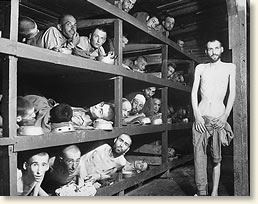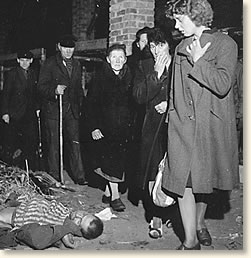|
Inside a Nazi Death Camp, 1944
Hitler established the first concentration camp soon after he came to power in 1933. The system grew to include about 100 camps divided into two types: concentration camps for slave labor in nearby factories and death camps for the systematic extermination of "undesirables" including Jews, Gypsies, homosexuals, the mentally retarded and others.
 |
Slave laborers in the
Buchenwald concentration camp
after its liberation by US forces.
April 16, 1945
|
As the allied armies raced towards final victory, advancing troops liberated
the camps one-by-one, revealing the horrors of the Nazi concept of establishing
a "pure" society. The first liberation came in July 1944 when Soviet troops entered
Maidanek, a death camp located in Poland two miles from the city of Lublin. Alexander
Werth, a correspondent for the London Sunday Times and the BBC, accompanied
the Soviet troops and described the camp shortly after its capture.
The BBC refused to air his report of the camp as his description was so unbelievable they considered it a Soviet propaganda ploy. It was not until the later capture of Buchenwald, Dachau and other camps on the western front that his description was accepted as true.
The Maidanek camp was established by the Nazis in 1941 soon after their conquest of the then Russian occupied region of Poland. The primary purpose of the facility was the speedy extermination of new arrivals (mostly Jews) transported in from various countries including Czechoslovakia, France, Austria, and Holland. The majority of victims, however, came from the immediate area. It is estimated that 1.5 million died at the camp during its three years of operation.
Soviet troops entered the camp in July 1944. A week later, Alexander Werth joined a group of fellow reporters in a guided tour of the facility:
"My first reaction to Maidanek was a feeling of surprise. I had imagined something horrible and sinister beyond words. It was nothing like that. It looked singularly harmless from outside. 'Is that it?' was my first reaction when we stopped at what looked like a large workers' settlement. Behind us was the many towered skyline of Lublin. There was much dust on the road, and the grass as dull, greenish-grey colour. The camp was separated from the road by a couple of barbed-wire fences, but these did not look particularly sinister, and might have been put up outside any military or semi-military establishment. The place was large; like a whole town of barracks painted a pleasant soft green. There were many people around - soldiers and civilians. A Polish sentry opened the barbed-wire gate to let cars enter the central avenue, with large green barracks on either side. And we stopped outside a large barrack marked Bad und Desinfektion II. 'This,' somebody said, 'is where large numbers of those arriving at the camp were brought in.'
The inside of this barrack was made of concrete, and water taps came out of the wall, and around the room there were benches where the clothes were put down and afterwards collected. So this was the place into which they were driven. Or perhaps they were politely invited to 'Step this way, please?' Did any of them suspect, while washing themselves after a long journey, what would happen a few minutes later? Anyway, after the washing was over, they were asked to go into the next room; at this point even the most unsuspecting must have begun to wonder. For the "next room" was a series of large square concrete structures, each about one-quarter of the size the bath-house, and, unlike it, had no windows. The naked people (men one time, women another time, children the next) were driven or forced from the bath-house into these dark concrete boxes - about five yards square - and then, with 200 or 250 people packed into each box - and it was completely dark there, except for a small light in the ceiling and the spyhole in the door - the process of gassing began. First some hot air was pumped in from the ceiling and then the pretty pale-blue crystals of Cyclon were showered down on the people, and in the hot wet air they rapidly evaporated. In anything from two to ten minutes everybody was dead. . .
 |
German citizens of a near-by town
are forced by American troops to view
the horrors of a concentration camp.
May 5, 1945
|
There were six concrete boxes - gas-chambers - side by side. 'Nearly two thousand people could be disposed of here simultaneously,' one of the guides said.
But what thoughts passed through these people's minds during those first few minutes while the crystals were falling; could anyone still believe that this humiliating process of being packed into a box and standing there naked, rubbing backs with other naked people, had anything to do with disinfection?
At first it was all very hard to take in, without an effort of the imagination. There were a number of very dull-looking concrete structures which, if their doors had been wider, might anywhere else have been mistaken for a row of nice little garages. But the doors - the doors! They were heavy steel doors, and each had a heavy steel bolt. And in the middle of the door was a spyhole, a circle, three inches in diameter composed of about a hundred small holes. Could the people in their death agony see the SS man's eye as he watched them? Anyway, the SS-man had nothing to fear: his eye was well protected by the steel netting over the spyhole...
...Then a touch of blue on the floor caught my eye. It was very faint, but still
legible. In blue chalk someone had scribbled the word "vergast" and
had drawn crudely above it a skull and crossbones. I had never seen this word
before but it obviously meant" gassed" - and not merely "gassed" but: with,
that eloquent little prefix ver, 'gassed out'. That's this job finished,
and now for the next lot. The blue chalk came into motion when there was nothing
but a heap of naked corpses inside. But what cries, what curses, what prayers
perhaps, had been uttered inside that gas chamber only a few minutes before?..."
References:
Gutman, Israel (ed.), Encyclopedia of the Holocaust (1990); Werth, Alexander, Russia at War 1941-1945 (1964).
How To Cite This Article:
"Inside a Nazi Death Camp, 1944" EyeWitness to History, www.eyewitnesstohistory.com (2004).
|






